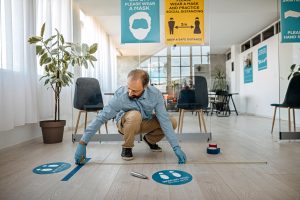How residential rehab services are adapting to Covid-19
Posted on 22 September, 2021 in Info

Since early 2020, rehabilitation services have been affected in very much the same ways as other frontline health services, with some providers forced to close or restrict access. Services still working directly with clients need to implement new hygiene and social distancing measures which can be especially challenging.
While they are trying to keep operations running efficiently, service providers have taken several new COVID-19-related steps to adapt to these challenges. Here are three examples of how the sector is adapting its practice.
Social Distancing
Social distancing within units is logistically and practically difficult. The residential rehab sector appears to be taking two approaches to socially distancing.
- Treating the whole unit as one large household by accepting there will be no social distancing between residents, instead focusing on social distancing between relatives and staff
- Breaking the unit down into smaller groups of residents, and maintaining social distancing between the different groups, as well as between them and staff.
Which of the two approaches is adopted will depend largely on the size, layout and demographics of the unit.
Whatever the approach, there are some simple measures that homes are adopting to minimise the risk of spreading the coronavirus:
- Reviewing the use of specific rooms, such as therapeutic rooms, for maximum flexibility
- Reconfiguring dining rooms, so that chairs are spaced further apart. Some have taken the step to stagger meal times
- Setting chairs further apart during group counselling sessions. In some homes, this has resulted in smaller group sessions
- Maintaining social distancing during 1:1 counselling sessions. Some settings use tape to mark out safe distances and safe areas
- Utilising the use of outdoor space
- Reminders – on posters, and in person – of the importance of maintaining distances between people and wearing face masks where necessary
- Requiring handwashing to become a regular activity throughout the day.
Duration of stay

Some residential programs last as little as four weeks, but some can run to 12. This can make a two-week isolation period for rehab treatment impractical, as it makes accessing group sessions difficult as well as one-to-one interactions. People entering rehab are typically anxious about the experience and making connections with other people experiencing similar challenges not only helps to ease such anxieties but is also an integral part of their treatment. Such connections become harder to establish if two-week isolation period is required.
Some settings, therefore, have shortened the isolation period, usually based on a negative COVID-19 test upon admission, and again after five days. Services must make their own assessments and reach judgements for each individual, based on what is best for the resident, and the centre as a whole. Examples of the sort of factors the residence’s management must consider include:
- Pre-admission risk assessment – identifying if a newly-admitted person has been able to effectively isolate before joining the residential program
- Vulnerability of the wider home – identifying residents who may be at higher risk
- Individual mental health – identifying if prolonged isolation may increase the risk of relapse
If this approach is to be adopted, it will be supported by careful risk assessment and management and discussed with commissioners and the Care Quality Commission.
With careful planning, involving the newly-admitted person, many of the issues relating to the isolation period can be greatly reduced.
Online
An increasing number of services have moved to web-based recovery programs, known as ‘remote rehab’. This is a newer form of outpatient drug rehabilitation that offers access to services anywhere there is a computer, tablet, or smartphone and an internet connection. Clients can connect to their counsellors and to others in their recovery peer group via video conferencing platforms.
Every aspect of the counselling found in a traditional outpatient rehab is purportedly available in an online addiction recovery program, from individual sessions to group therapy and counselling.
You can read more about web-based recovery programs here.
Above all, most of the steps and adaptations being implemented are designed with the primary intention of keeping both residents and staff safe.
Some residential centres have a blanket exclusion of new admissions where the person is displaying COVID-19 symptoms or delaying admission until symptoms have passed. Other homes are taking symptomatic people, ensuring they are carefully supported and isolated once in residence.
